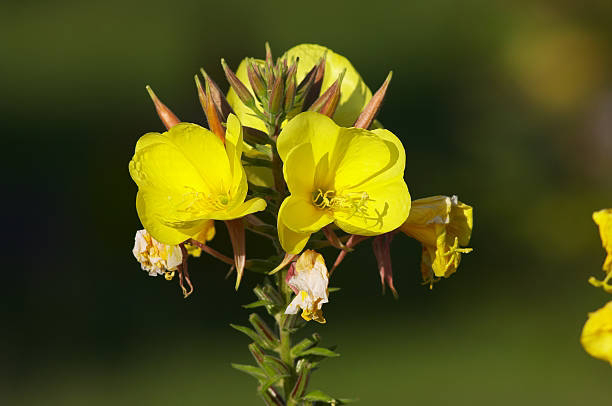The evening primrose (Oenothera biennis) isn't your average flower. With its captivating blooms that unfurl after dark and potential benefits for our health, this wildflower offers a story more intriguing than meets the eye. Let's delve into the fascinating world of the evening primrose:
-
Nighttime Spectacle: Unlike most flowers that greet the morning sun, the evening primrose takes center stage under the cloak of darkness. Its large, cup-shaped flowers unfurl as dusk settles, releasing a sweet, intoxicating fragrance to attract a unique cast of pollinators – moths and bats. Imagine a garden bathed in moonlight, illuminated by the soft glow of these pale yellow blossoms, their delicate petals unfurling in a silent symphony of nocturnal beauty.
-
A Legacy of Healing: For centuries, the evening primrose has been a trusted companion in traditional medicine cabinets around the world. Native American tribes revered its various parts – leaves, roots, and seeds – for treating a wide range of ailments, from wounds and infections to sore throats and coughs. Early European settlers, recognizing its potential, adopted these practices, solidifying the evening primrose's place as a historical healer.
-
The Secret Lies Within: Modern science has shifted its focus to the evening primrose's tiny treasure trove – its seeds. These unassuming seeds hold a unique fatty acid called gamma-linolenic acid (GLA), a potential key to unlocking various health benefits. Evening primrose oil, extracted from these seeds, has become a popular natural supplement, attracting attention from researchers and health enthusiasts alike.
-
Soothing Eczema's Discomfort: Scientific studies suggest that GLA possesses anti-inflammatory properties. This has sparked interest in its potential to alleviate the itching and discomfort associated with eczema. While further research is ongoing, the evening primrose oil may offer a glimmer of hope for those seeking natural relief from this chronic skin condition.
-
PMS Relief: A Question Mark: Evening primrose oil has been traditionally used to manage symptoms of premenstrual syndrome (PMS) like cramps, mood swings, and bloating. However, research on its effectiveness has yielded mixed results. Always consult a healthcare professional before using evening primrose oil for PMS to ensure it aligns with your individual needs and doesn't interact with any medications you're taking.
-
Menopausal Support (With a Caveat): Some studies suggest that evening primrose oil, when combined with other supplements, may offer some relief from the hot flashes experienced during menopause. However, more research is required to draw definitive conclusions. It's important to discuss the potential benefits and risks with your doctor to determine if it's a suitable option for you.
-
Beyond the Medicine Cabinet: The evening primrose offers more than just potential health benefits. It's a captivating addition to any garden. From late spring to early fall, its vibrant yellow flowers burst forth, creating a dazzling display that attracts a multitude of pollinators – bees, butterflies, and even those essential nocturnal visitors, moths and bats. These pollinators, flitting from flower to flower, ensure the reproduction of other plants and contribute to a healthy, balanced ecosystem in your backyard haven.
-
Champion of Drought: Water restrictions got you down? The evening primrose thrives in hot and dry conditions. This low-maintenance marvel requires minimal watering, making it a perfect choice for water-conscious gardeners. Imagine a vibrant flower bed flourishing even during scorching summers, showcasing the evening primrose's remarkable resilience.
-
A Self-Seeding Surprise: Here's a delightful secret about the evening primrose – it readily reseeds itself! This means you can enjoy its vibrant display year after year without the hassle of constant replanting. Nature takes care of the propagation, ensuring a delightful surprise each spring as new seedlings emerge, ready to add their charm to your garden.
-
A Pollinator Paradise: The evening primrose isn't just beautiful; it plays a vital role in the delicate balance of the ecosystem. Its fragrant flowers attract a variety of pollinators, particularly moths and bats with their excellent night vision. These essential creatures transfer pollen between plants, ensuring their reproduction and the continuation of a thriving ecosystem.
-
Night Vision Advantage: Moths, unlike many daytime pollinators, have exceptional night vision. The evening primrose's pale yellow blossoms and sweet fragrance are perfectly adapted to attract these crucial nocturnal visitors. Imagine the flowers acting as beacons in the darkness, guiding moths to their evening feast, a testament to the intricate co-evolution between plants and pollinators.





